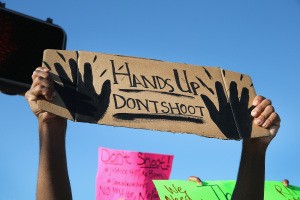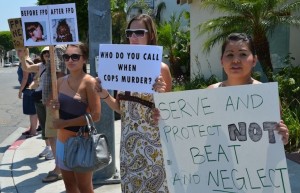Confronting the Rhetoric of “Black on Black Crime”: A Response to Derailing Strategies
By Xhercis Méndez
This article is dedicated to all those who seek to produce justice in the face of state sanctioned violence vis-à-vis police brutality, or what is understood in its sanitized version as “excessive force” targeting marginalized communities. Here, I define and examine a set of derailing strategies currently being used by mainstream media and state representatives to halt all conversation and protest regarding a long and well-documented history of police brutality and to detract us from the possibility of building broad-based coalitions.
What are derailing strategies? Derailing strategies are rehearsed responses by the state, media representatives, and/or individuals that seek to derail and/or shift the focus of a conversation or debate in such a way that all conversation of the original issue ceases. The intent of a derailing strategy is to divert attention away from the main concern, to halt conversation, by introducing new sets of concerns that are more often than not tangentially related but that are framed in such a way as to seem relatively more pressing to address. While derailing strategies can be mobilized by anyone, regardless of intention, these strategies carry more weight when deployed by state officials and media representatives because they are in a position to frame the conversation and (re)prioritize what questions should and should not be answered.
A powerful example of this is when Black communities protest the systematic assault by police on their communities and a Fox news pundit, media representative, or even a professor counters by asking, What about Black on Black crime? This is a derailing strategy because people feel compelled to respond to the question of “Black on Black crime,” while the conversation regarding police brutality is interrupted. However, it is a mistake to respond to the question of “Black on Black crime.” It is a classic derailing strategy because it seeks to turn the focus away from the issue at hand and onto the protesting community, as if to say that you are not allowed to call out the violence of the state unless everything and everyone in your community is in order. It is also a derailing strategy because it suggests that one issue necessarily replaces the other.
Here a potential response could be, Why are you raising the question of “Black on Black crime”? Is it because you think that somehow the fact that “Black on Black crime” exists as a phenomenon that we should cease calling out what is a very long and evidenced history of police brutality targeting Black communities (the most recent examples of which are the Justice Department’s reports on racial profiling and “excessive force” in both Ferguson and Cleveland)? Are police brutality and “Black on Black crime” somehow mutually exclusive in your imagination? In other words, do you think that if “Black on Black crime” exists, then somehow the issue of police brutality doesn’t, or that as long as “Black on Black crime” exists, we should never bring up the issue of police brutality? If the answer is no, then let us return to the issue at hand, which is about addressing all of the ways in which police have been given the power to “use excessive force” and even murder with impunity when it comes to Black communities.
Another derailing strategy connected to police brutality is how the state and media frame what a “crime” is and who counts as an appropriate “victim” depending on who is perpetrating the violence. When the purveyors of violence are police, the violence is always presumed to be justified. Police violence is framed as a justifiable response to the “threatening” behavior of the victim. However, to what extent should the presumption of threatening behavior carry with it a death sentence? In the case of Mike Brown, Rekia Boyd, and Eric Garner, this derailing strategy draws on the long history of representing Black bodies as innately criminal, making this particular framing of the issue easily “understandable” and even beyond reproach to most who are consuming these media and state messages. It is only through the production of an innate criminality that “hands up, don’t shoot” (a plea for less violence enacted at the hands of police) is undermined by the response “hands up, don’t loot” (the claim that if members of the Black community were not out here committing crimes, they would not be shot in the first place).
Notably, this response is directed not only at Black communities in particular but is also directed at other communities of color that are understood to be inherently criminal. As my sister in struggle Ganessa James wrote to me in an email, this strategy tends to “routinely drag through the mud the actions, history, and character of those assaulted in order to justify the judge/jury/executioner approach of police on the street.”[1]
As a result, when we are discussing the murder with impunity of Black lives and Black life, as Fred Moten suggests the problem is framed in a way that works to emphasize the “innately criminality” of those assaulted and obscure the pattern of “excessive force” of those doing the assaulting. Moreover, if and when police are held in any way accountable, state officials and mainstream media make a point of framing their behavior as individual instances of questionably inappropriate behavior that at most, or at best, constitute “a few bad apples.” By framing the issue in this manner, what is obscured is the fact that what people are calling out is not any one set of individuals, but the standard operating procedures of the state and police which are grounded in a whole system and history of sanctioning violence against Black communities in particular and marginalized communities more broadly (#indictthesystem).
While the excessively violent actions of any one police officer are not construed as a generalizable threat to the public (see the before and after coverage on the subway conductor assault by off-duty police officer), the flip side of this strategy includes framing any and all violence coming from Black individuals as a generalizable threat to all. For example, that was the case with the recent shooting of the two NYPD police officers by Ismaaiyl Brinsley. In a recent interview, Mayor de Blasio was quoted as saying that, “an attack on [police officers] was an attack on all of us, attack on our democracy, attack on our values, attack on every single New Yorker.” In this instance, Brinsley’s individual actions have now been translated into a generalizable threat that then serves to justify the status quo and the systemic abuse and violent targeting of Black communities.
The coverage of the slain NYPD officers served another derailing function in that it successfully shifted the terms of the original conversation away from police brutality and distorted it into what is now the perceived violence and threat of protesters. News outlets reported that Brinsley’s targeting of police was a direct response to the lack of indictments in the Brown and Garner cases. Linking this individual’s actions to the protests was a derailing strategy because it shifted the focus away from the relatively large-scale peaceful protests that have been taking place across the country advocating for new policing approaches with respect to Black communities towards a conversation about the safety of police. This crime was used to attempt to halt a necessary conversation on an evidenced practice of generalizable state/police violence and pressure the mayor of NYC to call for the halting of protests altogether, because “our first obligation is to respect these families in mourning…it’s time to put aside political debates, put aside protests.”
And yet what about the countless families mourning the loss of their loved ones as a result of “excessive force” enacted by police? Is our first obligation not also to mourn with them? What are these protests, if not a collective mourning? Let me be clear, I DO NOT believe that the NYPD officers that were murdered should have been harmed in any way. However, I also DO NOT believe that because they were killed we should cease the discussion on what has already been acknowledged by the state as a systemic problem of police unjustifiably using excessive force on and in Black communities.
So the question is, how do we get the conversation back on the table in the face of these derailing strategies? Here is where we can use a multiplicity of concerns and communities to our collective advantage. The issue of state sanctioned violence vis-à-vis the police and its increasing militarization is both a local as well as an international issue (e.g., Palestine or the recent case in Mexico where local police disappeared 43 students). While I do not pretend to have a clear sense of how coalitional organizing can take shape globally, I can say that we stand to gain from identifying linkages (not to be confused with commonalities) between the various targeted communities at both local and global scales. On a local level, we see that in addition to Black communities, other targets of police violence include but are not limited to immigrants, Latinos presumed to be illegal or criminal, poor white folks, impoverished people more generally, transgender, queer and gender non-conforming folks, anyone identified as Muslim post-911, the mentally ill, the homeless, the disabled, and the list goes on.
Significantly, the galvanization around Eric Garner and Michael Brown makes room for us to examine how this state-sanctioned violence also plays out in relation to other marginalized communities locally. The goal here is to combine the diversity of issues being brought to the fore by various marginalized groups in relation to the system of policing and NOT to insist on the prioritization of one group (the “most oppressed”) over against the targeting of any other group and/or vice versa. Rather than prioritize the issues of any one of the targeted communities regarding violences enacted by police, the goal here would be to recognize how each community is adding to the collective evidence of systemic abuse. In other words, what we would end up with is the collective evidence of ALL the communities that are systematically harmed by and through policing practices as opposed to being “protected and served.” Rather than vying for primary focus, an approach that moves us towards disaggregation and away from building a coalitional front, the aim is to identify how our varied issues and concerns with the standard operating procedures of the state and its sanctioned agents are not necessarily mutually exclusive.
Although not always the case, I have seen that in the attempt to prove that one issue is more important or fundamental than the other (think: racism vs. transphobia, or the anti-immigrant logic that undergirds police violence), we are working against each other. We are working against each other if the project is to be recognized as the “most oppressed.” Indeed, what is the prize for being recognized as the “most oppressed”? Is it sympathy? Is it a recognition of our humanity? Is it the possibility of having a moral high ground? Will it help us tap into an ethical/moral base for change? On the contrary, what we end up with are communities and injustices that become minoritized in their isolation from one another.
Given the historical record, I do not hinge my hopes on such recognitions by the state and its agents. Instead, I would rather look to my left and right and see who else has been negatively impacted by these standard operating procedures, even if not in the same ways. It is with this in mind that I consider multiplicity in both the communities and concerns that come to the fore to be a strength and not a destructive force. Indeed, the more groups we recognize as also being victims of police violence, even when that violence manifests differently in each case, the more we are empowered to ask, Who are the police set up to protect and serve? The greater the evidence we collect, the more we are able to see practices of state sanctioned violence and differential application of the law based on an idealized notion of the citizen. That is, the ideal citizen is the kind of individual NOT systemically targeted by standard policing practices.
The more evidence we collect, the more people we will have fighting for accountability and change, even if the standard operating procedures they are challenging are different from the ones we are taking issue with. The goal here is NOT to demand that groups ignore their specificity or particular issues in exchange for a singularity of purpose. Rather than conflating say anti-immigrant logic, which targets particular groups and manifests in a distinct set of “crimes” (e.g., not having proper ID, an issue that also affects trans-identified folks albeit differently), with racism, perhaps our coalitional possibility lies in our piling up all of the distinct strategies and assaults on humanity police have been given carte blanche to perform. Again, this is not about specific individuals acting outside of protocol, but rather about how the protocol itself needs to be under scrutiny.
In this sense, each new concern would be like adding logs to a fire, allowing the fire to grow in ferocity until the fire demanding justice is so big that the state has no choice but to acknowledge the collective flames or be taken over by the ever-spreading heat. Far from destructive, combining distinct yet interrelated sets of concerns pertaining to state-sanctioned violence can in fact be one of our greatest strengths. It is amidst these distinct yet interrelated issues that the state has no choice but to recognize that dismantling the arguments or derailing the issues of one group will not undo the larger web of evidenced violence and complaints that have been interwoven and amassed as a result. However, this will only work if we begin to acknowledge the connective tissues between variously marginalized communities locally, as opposed to becoming isolated in our struggles. (A good example of seeking the connective tissues between us on a global scale is the recent trip by the Dream Defenders to Palestine).
It is in the face of this multiplicity that invoking “Black on Black crime” will not be enough to halt the conversation and protests against police brutality, because this derailing strategy will not work against the diversity of groups bringing this issue to the fore. Not only can we ask, what does “Black on Black crime” have to do with the concerns being presented by Black communities, but we can also ask: What does it have to do with the number of Muslim students who have been targeted and harassed by police? What does “Black on Black crime” have to do with the number of immigrants who have been beaten, killed, and or disappeared by police? What does “Black on Black crime” have to do with the number of transgender, queer-identified, and gender non-conforming folk who have been harassed, assaulted, and abused by police?
The problem is not about any one set of individuals, but rather a system that has been grounded and built on the targeted violence against marginalized communities. It is here where our multiplicity of concerns has the potential to strengthen our collective voice and build bridges to each other where we were able to see none before.
[1] I want to thank my intellectual/political comadre Ganessa James for these instructive and nuanced suggestions re: the extent to which presumed to be threatening behavior carries with it a death sentence that is later justified through state rhetoric and media coverage.
__________________________________
 Xhercis Méndez is Assistant Professor of Women and Gender Studies and affiliated faculty in the African American Studies Program at California State University, Fullerton. She received her doctorate in the Philosophy, Interpretation and Culture Program at Binghamton University, along with certificates in Feminist Theory and Latin American and Caribbean Area Studies. Her most recent publication, “Transcending Dimorphism: Afro-Cuban Ritual Praxis and the Rematerialization of the Body,” explores how practitioners’ of Afro-Cuban Santeria are reconfigured through ritual practice and simultaneously produced as non-gendered, adding another layer to the intersectional analyses of power in spaces both within and beyond ritual practice. Her work brings together Women of Color and Decolonial Feminisms, Sexuality Studies, and Afro-Latin@/diasporic Religion, Philosophies, and ways of knowing in an effort to explore alternative grounds for the (re)making of social relations, histories, intimacies, and resistant possibilities.
Xhercis Méndez is Assistant Professor of Women and Gender Studies and affiliated faculty in the African American Studies Program at California State University, Fullerton. She received her doctorate in the Philosophy, Interpretation and Culture Program at Binghamton University, along with certificates in Feminist Theory and Latin American and Caribbean Area Studies. Her most recent publication, “Transcending Dimorphism: Afro-Cuban Ritual Praxis and the Rematerialization of the Body,” explores how practitioners’ of Afro-Cuban Santeria are reconfigured through ritual practice and simultaneously produced as non-gendered, adding another layer to the intersectional analyses of power in spaces both within and beyond ritual practice. Her work brings together Women of Color and Decolonial Feminisms, Sexuality Studies, and Afro-Latin@/diasporic Religion, Philosophies, and ways of knowing in an effort to explore alternative grounds for the (re)making of social relations, histories, intimacies, and resistant possibilities.

Pingback: Tribalism in Clay’s Ark | Speculative Fiction
Pingback: Confronting the Rhetoric of “Black on Black Crime”: A Response to Derailing Strategies | nochipsnopeace